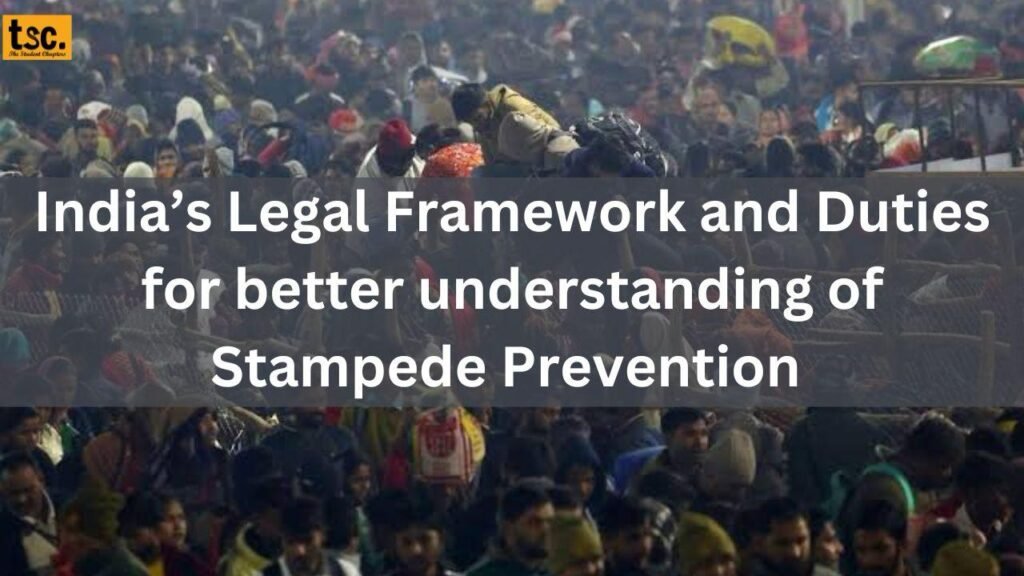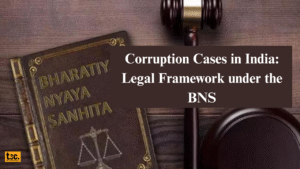India’s Legal Framework for better understanding of Stampede

Let’s study India’s Legal Framework and Duties for better understanding of Stampede Prevention. In India, stampedes, particularly at religious or public gatherings, have unfortunately been a recurring issue. Although there is no specific national law solely governing stampedes, there are several general legal provisions and regulations that address safety concerns and responsibilities that can indirectly help prevent or manage such incidents.
India’s Legal Framework and Duties for Stampede Prevention
1. Criminal Liability
Section 106(1) (Causing Death by Negligence) of the Bharatiya Nyaya Sanhita (BNS) : The culpable individuals or organisers may be charged under this section if a stampede results in deaths brought on by negligence (such as a failure to provide sufficient safety measures). It carries a maximum two-year jail sentence, a fine, or both. The Bharatiya Nyaya Sanhita (BNS) Sections 125, which deal with acts that endanger life or personal safety, state: Whether or whether someone dies during a stampede, these parts may still be applicable if their acts cause harm.
2. Public Safety and Crowd Control Regulations
- The Disaster Management Act, 2005: This law contains guidelines for planning and overseeing public safety during emergencies, especially situations involving large crowds. It gives authorities the ability to efficiently oversee public gatherings and take preventative action.
- The Bharatiya Nagarik Suraksha Sanhita, 2023 (BNSS) and the Police Act of 1861: These rules give police the power to control public gatherings and make sure that those in charge adhere to safety regulations. Authorities have the right to intervene if they think an event could endanger public safety (for example, because of crowding).
- Other Safety Laws and the Factories Act of 1948: Certain events, including religious services or sizable public meetings hosted at certain locations, require organisers to make sure that safety rules—such as those pertaining to crowd control, emergency exits, and structural safety—are followed.
3. Regulations for Religious Events and Pilgrimages
In India, several state governments have established particular regulations and policies for handling sizable religious gatherings (such as the Kumbh Mela and the Amarnath Yatra). It occurred recently too in MahaKumbh. These rules address:
- Crowd control strategies such appropriate signs, designated paths, and barrier locations.
- An enough amount of emergency services and police officers.
- Medical amenities, such as ambulances and first aid stations.
4. Responsibilities of Organizers
Event planners have an obligation to participants to ensure that safety regulations are followed. An organiser could face both criminal and civil penalties if they neglect to take the required precautions, which could result in a stampede. In certain situations, the relatives of the victims may seek damages for carelessness.
5. Court Rulings
Numerous decisions have highlighted the duty of authorities and event planners to avert such disasters. According to court rulings, it is the primary duty of both authorities and organisers to ensure the safety of huge crowds, and any failure to do so that results in a stampede may have serious legal repercussions.
6. Recent Legislative Moves
Stricter laws and improved safety enforcement have been demanded in reaction to frequent stampedes during public or religious gatherings. Certain governments have implemented state-level laws, such the Madhya Pradesh Crowd Control Act, which stipulates particular safety requirements and guidelines for religious gatherings, such as crowd caps, sufficient security guards, and medical facilities.
Conclusion of India’s Legal Framework and Duties for better understanding of Stampede Prevention
Although India does not have a single legislation that addresses stampedes, the laws pertaining to crowd control, public safety, and negligence are very important in dealing with these kinds of situations. Preventing stampedes and maintaining public safety during major gatherings requires holding organisers accountable, controlling crowd sizes, and having appropriate emergency preparations. This is an Overview of India’s Legal Framework and Duties for Stampede Prevention.
Stay tuned on our website as if any official information pops up then we will update you in minutes! If you want all the latest updates on time then join our student community on WhatsApp!
Choose the right career yourself by booking personal guidance from professionals on Mytagapp.com









